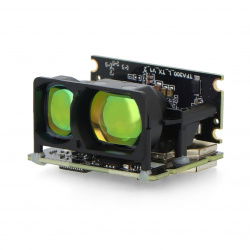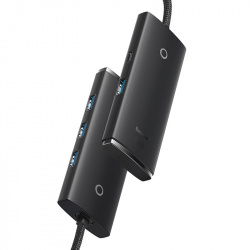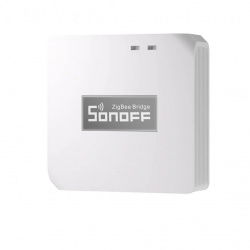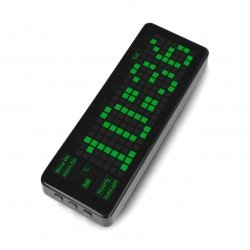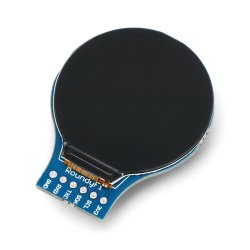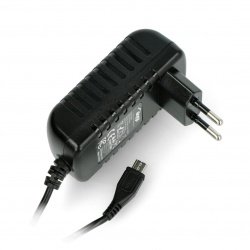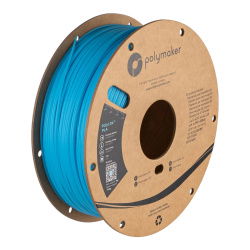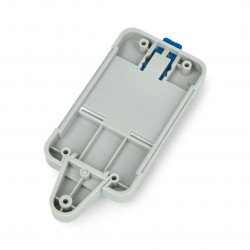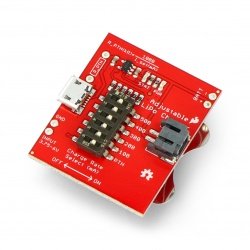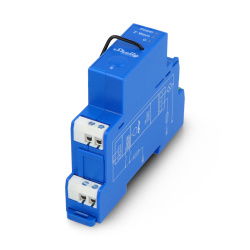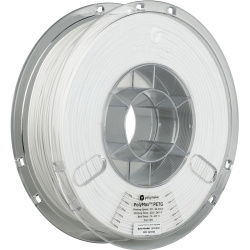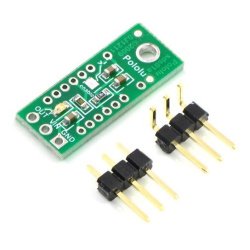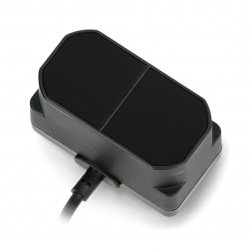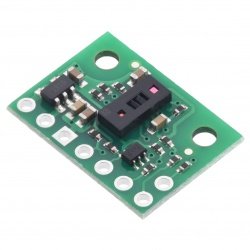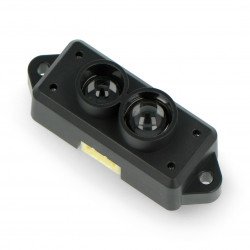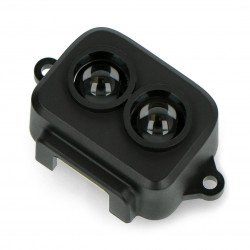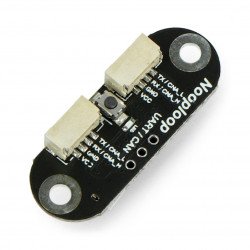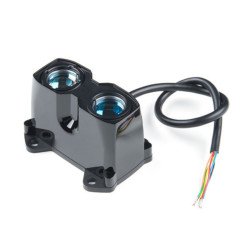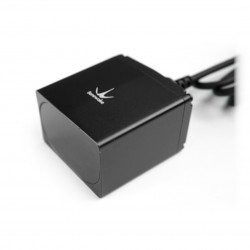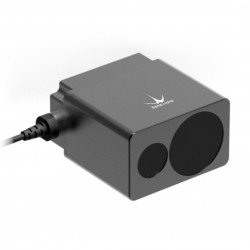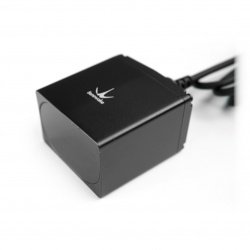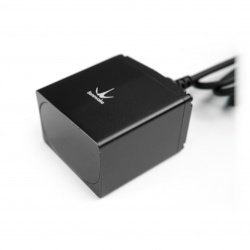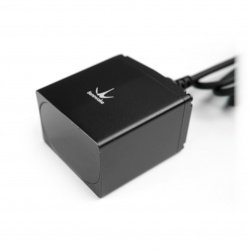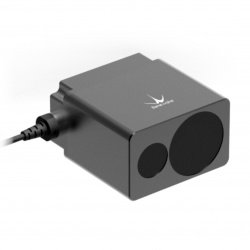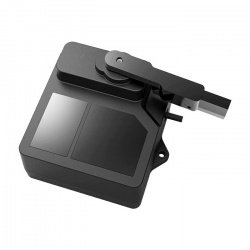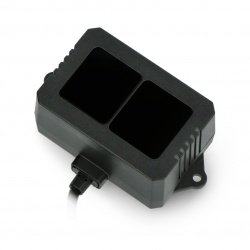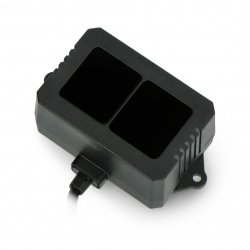Electronic distance measurement is used in construction, renovation works, mobile robotics, automatic vehicles, and even drone control or systems for military purposes. Of primary importance for the performance of a given rangefinder model is the technology used in it, with the laser methods being by far the most promising and at the same time the most developed by many leading manufacturers. Fortunately, the achievements of modern optoelectronics have already made it "under the roof", and amateurs can successfully use dozens of models of distance sensors, compatible with the most popular development and prototyping platforms.
Time of flight sensor
Laser distance sensor Lidar TFMini Plus UART / I2C - 12m
Precise, laser distance sensor operating in the range from 0.1 to 12 m with an accuracy of 0,05 m. The supply voltage is 5 V. The device communicates using the UART and I2C...ToF4M - 400cm distance sensor - VL53L1X - Unit extension module - M5Stack U172
Distance sensor module that uses Time-of-Flight (ToF) technology and the VL53L1CXV0FY/1 sensor. It is capable of measuring the height of objects, detecting the presence of...VL53L5CX time-of-flight - 8x8 distance sensor I2C - 400cm - Pololu 3417
The VL53L5CX laser distance sensor measures up to 400 cm using the Time-of-Fligh t method via the I2C interface. With it, it is possible to measure the absolute distance...VL53L7CX time-of-flight - 8x8 I2C distance sensor - 350cm - Pololu 3418
VL53L7CX laser distance sensor measuring in the range of up to 350 cm using the Time-of-Flight method via the I2C digital interface. It has a wide field of view and the...Laser distance sensor Lidar TFMini-S UART / I2C - 12m
Laser distance sensor that measures precisely from 0.1 m to 12 m with an accuracy of 0.06 m. The blind spot has been reduced to 10 cm. The sensor communicates through the...Lidar TF Luna- laser distance sensor - 8m - UART/I2C
Very accurate laser sensor measuring distance from 0.2 m to 8 m with an accuracy of 0.06 m . The sensor is powered by 5 V. Lidar TF Luna communicates via UART or I2C...Arduino Modulino Distance - VL53L4CD ToF distance sensor - Qwiic - ABX00102
The Modulino Distance ABX00102 is a precision time-of-flight (ToF) distance sensor based on the VL53L4CD chip. It enables fast presence detection and accurate distance...TOF laser distance sensor -8m - UART/CAN - DFRobot SEN0337
Laser sensor based on ToF (Time of Flight) measurement technology. It detects objects in the range from 0.01 m to 5 m with an accuracy of 1.5 cm . The measuring resolution...Laser distance sensor Lidar Lite v3HP I2C/PWM - 40m - SparkFun SEN-14599
Accurate, laser distance sensor operating in the range from 0.05 to 40 m with an accuracy of 0.025 m. The supply voltage is from 4.75 V up to 5.5 V. The device is communicating...Lidar laser distance sensor - 20m - I2C/UART - Benewake TFS20-L
The TFS20-L miniature LiDAR module from Benewake is a lightweight and precise rangefinder based on dToF technology, offering measurement up to 20 m . The measurement...- New
Lidar laser distance sensor - UHF 10000Hz - 270m - UART/CAN - for drones and UAVs - Benewake TFA300
The TFA300 LiDAR module is an advanced solution with a measurement frequency of up to 10,000 Hz , enabling accurate monitoring of the surroundings of drones, UAVs, and...- New
Rangefinder - TF03 LiDAR sensorIP67 - 180m - UART, CAN
Accurate laser distance sensor operating in the range from 0.1 to 180 m with an accuracy of 0.1 m. The supply voltage is 5 V. The device communicates using the UART, CAN,...Rangefinder - TF03 LiDAR sensor IP67 - 100m - UART, CAN
Precision laser distance sensor operating in the range from 0.1 to 100 m with an accuracy of 0.1 m. The supply voltage is 5 V. The device communicates via UART, CAN interface....Rangefinder - TF350 LiDAR sensor IP67 - 350m - UART, CAN
Precision laser distance sensor operating from 0.1 to 350 m with an accuracy of 0.1 m. The supply voltage is 5 V. The device communicates via UART, CAN interface. It has a...Rangefinder - TF03 LiDAR sensor IP67 - 180m - RS485/RS232
Industrial, fast laser LiDAR distance sensor measuring in the range from 0.1 to 180 m with an accuracy of 10 cm (in the range of 10 m). LiDAR TF03 is supplied with...Rangefinder - TF03 LiDAR sensor IP67 - 180m - analog
The Benewake TF03 is a fast, industrial, LiDAR laser distance sensor measuring in the range from 0.1 to 180 m with an accuracy of 10 cm (in the range of 10 m). It is...Rangefinder - TF03 LiDAR sensor IP67 - 100m - RS485/RS232
Fast, industrial-grade LiDAR laser distance sensor, measuring distances in the range from 0.1 to 100 m with an accuracy of 10 cm (in the range of 10 m). The Benewake LiDAR...Rangefinder - TF350 LiDAR sensor IP67 - 350m - RS485/RS232
Industrial, laser distance sensor Benewake LiDAR TF350 operating in the range from 0.1 m to 350 m, measures with an accuracy of 0.1 m. It is equipped with a...Rangefinder - TF350 LiDAR sensor IP67 - 350m - analog
Benewake LiDAR TF350 is an industrial-grade laser distance sensor operating in the range from 0.1 m to 350 m, measures with an accuracy of 10 cm. It is equipped with a...Rangefinder - TF02-Pro-W LiDAR sensor IP5X - 25m - UART/I2C
Single-point laser distance sensor LiDAR TF02-Pro-W designed to detect the fill level. The sensor is based on ToF technology, its distance detection range is from 0.1 m to...Rangefinder - TF02-Pro-W LiDAR sensor IP5X - 25m - RS485
The TF02-Pro-W LiDAR laser distance sensor is based on ToF technology. The distance detection range is 0.1m to 25m . The module is equipped with a wiper mounted on a...Lidar TF02-i IP65 - laser distance sensor - 40m - CAN
Benewake LiDAR TF02-i laser distance sensor, which measures in the range from 0.1 m to 40 m with an accuracy of 0.05 m . It is supplied with the voltage from 7 V to 30 V....Lidar TF02-i IP65 - laser distance sensor - 40m - RS485
Benewake LiDAR TF02-i is a laser distance sensor with a measuring range from 0.1 m to 40 m with an accuracy of 0.05 m . The sensor is supplied with the voltage from 7 V to...Time-of-Flight distance measurement
As the name suggests, measuring the distance of objects using the Time-of-Flight method is based on determining the time of flight of the light beam from the transmitter to the obstacle, and then (after reflecting from it) back. The time from sending a light impulse to its re-acquisition is therefore twice as long as it would result from the distance between the rangefinder and the detected object - this simple principle of operation, with the knowledge of the speed of light propagation in the air (close to the speed in vacuum), allows you to quickly calculate the actual the distance traveled by the photons. So much for the theory - practice, as usual, turns out to be a bit more complicated, because it is worth noting that at the enormous speed of light (300,000 km/s), the time in which light travels a distance of 1 cm is only 67 ps (1 picosecond = 1/1000000000000 seconds)! ToF sensors are therefore extremely advanced electronically, because they must work in a very strong time regime. Fortunately, today such advanced elements are available even to electronics amateurs and at incredibly affordable prices.
Laser distance sensors - what to choose for distance measurement in different applications?
When choosing a modular or integrated rangefinder, you should ask yourself what parameters do we expect from our sensor? Tiny integrated sensors, e.g. VL53L5CX, usually offer a relatively small measuring range, not exceeding a few meters, but their accuracy reaches even single millimeters - therefore they are perfect for small mobile robots (including minisumo). If you plan to build a very fast-moving vehicle (e.g. a drone), it is worth paying attention to slightly larger modules with an incomparably longer range. For example, the analog Lidar TF03 module allows you to measure distances up to 180 meters, and the TF350 - even 350 meters! In addition, these devices have an IP67 tightness class, thanks to which they can work even in the most unfavorable weather conditions.






























































































































































































































































































































